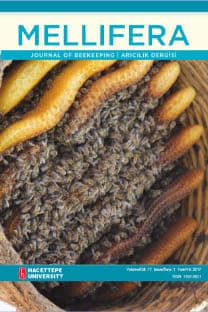Pollen Morphology of Hedera helix L.
Pollen Morphology of Hedera helix L.
Hedera
helix (Ivy) is an everygreen dioecious wood and liana.
It is one of the best species of Hedera
(Araliaceae). In traditional use, many parts of this plant have been used for
treatment of various diseases. In this study, pollen morphology of H. helix L. belonging to the genus Hedera (Araliaceae) were examined with
light microscopy (LM). According to the investigation by LM, pollen grains of
the species are monad, radially symmetrical, isopolar, tricolporate,
oblate-spheroidal or prolate-spheroidal, colporate, reticulate and rugulate.
In my opinion, the palynological features
of the taxon might be helpful to investigate the taxa various palynological,
taxonomical, melissopalynological and pharmaceutical researches.
Keywords:
Araliaceae, light microscope, palynology taxonomy,
___
[1] DAVIS, P H (ed.). 1965-1985. Flora of Turkey and the East Aegean Islands, vol.1-9, Edinburgh.[2] BOI, M; ANTONIO LLORENS, J; CORTÉS, L; LLADÓ, G; LLORENS L. Palynological and chemical volatile components of typically autumnal honeys of the western Mediterranean Grana, 2013.Vol. 52, No. 2, 93–105, http://dx.doi.org/10.1080/00173134.2012.744774.
[3] GARBUZOV, M; RATNIEKS, F L W (2014) Ivy: an underappreciated key resourceto flower visiting insects in autumn.Insect. Conserv. Diver.7, 91–102. doi:10.1111/icad.1203
[4] PERSANO ODDO, L; PIRO, R (2004). Main European unifloral honeys: Descriptive sheets. Apidologie, 35, S38–S81.
[5] MAKOWICZ, E; KAFARSKI, P; JASICKA-MISIAK, I (2018) Chromatographic fingerprint of the volatile fraction of rare Hedera helix honey and biomarkers identification Eur Food Res Technol 244: 2169. https://doi.org/10.1007/s00217-018-3127-z
[6] LIXANDRU, M (2017) Properties and benefits of ivy honey. https ://www.natur eword.com/properties -and-benef its-of-ivy-honey / Accessed 7 Jan 2018.
[7] KAYA, Z.; BİNZET, R; ORCAN, N (2005) Pollen analyses of honeys from some regions in Turkey. Apiacta, 40, 10.
[8] ÖZLER, H (2018) POLLEN ANALYSIS OF THE HONEY FROM SOUTH ANATOLIA. Uludağ Arıcılık Dergisi – Uludag Bee Journal 2018, 18 (2): 73-86
[9] https://www.haritatr.com/giresun-haritasi-i160 erişim ağustos 2018
[10] WODEHOUSE, R P (1935) Pollen Grains. McGraw Hill, New York.
[11] ERDTMAN, G (1952) Pollen Morphology and Plant Taxonomy. Angiosperms. Chronica Botanica Co., Waltham, Massachusettes.
[12] KREMP, O W (1965). Morphologic Encyclopedia of Palynology. Univ. of Arizona Press Tucson, 263 pp.
[13] PUNT, W; HOEN, P P; BLACKMORE, S; NILSSON, S; LE THOMAS, A (2007) Glossary of Pollen and Spore Terminology. Rev Palaeobot Palynol, 143: 1-81.
[14] (http://pllen.tstebler.ch/MediaWiki/index) (Date of access: 04.04.2018.)
[15] (https:/www.paldat.org/) (Date of access: 04.04.2018).
- ISSN: 1302-5821
- Başlangıç: 2001
- Yayıncı: Hacettepe Üniversitesi
Sayıdaki Diğer Makaleler
Beekeeping Activities in Turkey and Algeria
Halima Saadia TAMALİ, Aslı ÖZKIRIM
Muammer KAPLAN, Öznur KARAOĞLU, Sibel SİLİCİ
An Evaluation on Bee Bread: Chemical and Palynological Analysis
Muammer KAPLAN, Öznur KARAOĞLU, Sibel SİLİCİ
Halima Saadia TAMALİ, Aslı ÖZKIRIM
